 Back to selection
Back to selection
“We Wanted to Keep the Light as Unobtrusive as Possible”: A Star is Born Cinematographer Matthew Libatique
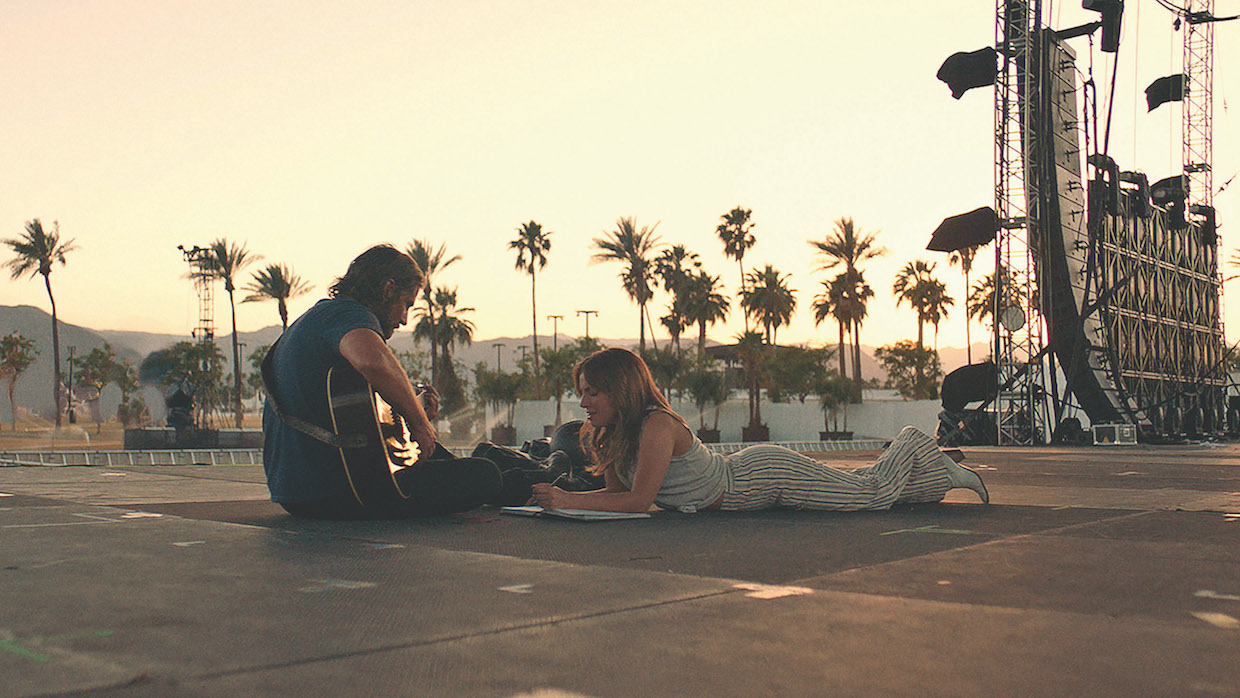 Bradley Cooper and Lady Gaga in A Star is Born
Bradley Cooper and Lady Gaga in A Star is Born This is not a good time to be in love. At least not if you’re a movie character in an awards season that is awash in tragically doomed romances. In the last week alone I’ve seen couplings quashed by systemic racism (If Beale Street Could Talk), politics (Cold War), and unconquerable inner demons (a second go-round for me with A Star is Born). No one seems to be swimming off into the sunset with their fishman this year.
In addition to ill-fated relationships, Beale Street, Cold War and A Star Is Born share another common element — sumptuous cinematography. In A Star Is Born, that comes courtesy of Matthew Libatique. A longtime collaborator of director Darren Aronofsky (Requiem for a Dream, Black Swan, mother!), Libatique has shot everything from gargantuan superhero movies (the first two Iron Man flicks and Venom) to obscure subgenres like “subtle Joel Schumacher indies” (Tigerland) and “Spike Lee popcorn movies” (Inside Man).
Directed by Bradley Cooper, the fourth incarnation of A Star Is Born finds Cooper playing a country musician laid low by drink and depression as the career of his protégé (Lady Gaga) ascends. The movie picked up five Golden Globe nominations this week — including one for best picture — which seems like an opportune time to share Libatique’s chat with Filmmaker about changing his on-set color process, marveling at Dave Chappelle’s thespian chops, and the importance of staying loyal to your lens rental house.
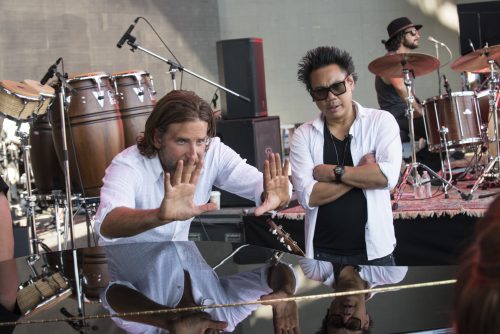
Filmmaker: When I do these stories I’ll look at a decent number of other interviews and then I’ll try to only ask questions I don’t already know the answer to. That’s hard to do with your work on A Star Is Born because it has already been written about so much.
Libatique: Well, the more of these I do, the better my answers get. (laughs) So you’re fine.
Filmmaker: One thing I haven’t read you talk about much is your on-set color workflow.
Libatique: A Star Is Born was actually the last film I shot that I didn’t use a show LUT for. Instead I would set looks based on each scene, tweaking the color and the contrast, and then I would get stills from the DIT, color correct them, and send them off as a reference for the colorist, who would match them.
Filmmaker: What made you change that process? Were you just tired of spending the extra time grading stills at the end of the shoot day?
Libatique: That was the first inspiration. (laughs) Spending an extra two hours a night grading stills was starting to get laborious. I do still like to tweak on set, but I do it less. I was never comfortable before with show LUTs. I found that when I used a neutral LUT with a digital camera I would use less light, but when I used a custom show LUT I ended up using more light. That’s the main reason why I hadn’t been using them.
Filmmaker: Does it make the final grade easier, though, when you’ve done scene-to-scene adjustments like on A Star Is Born? That process probably takes you into the DI with a look that’s closer to what you want the final result to be.
Libatique: It’s always so much easier when the look is already established. If I’m doing my scene-to-scene corrections, all that information tracks all the way through (to editorial and to the color grade). Same thing if I’m using a show LUT, that LUT tracks all the way through. It’s really just about everybody == well, mainly myself and the director — signing off on the look going into postproduction so that (the footage) is being seen the way it’s meant to be seen in terms of color and contrast.
Filmmaker: Let’s talk a little bit about the lenses you used on the film. You went with a combination of the Cooke Anamorphic/i SF primes and Kowa Cine Prominars.
Libatique: Those Cookes feel like they’re somewhere in between a C Series and a G Series Panavision lens. They are very clean like the G Series and render color similarly, but they have a little bit more of the artifacts you get with the C Series. So the Cookes were kind of my base lens package and then when I wanted to get a dirtier look I would switch to the Kowa anamorphics. Most of the things you see on stage, specifically the tight shots of Bradley and Lady Gaga when they are performing, were shot on Kowa anamorphics.
The set of Cookes was tweaked specifically and matched by (the Los Angeles rental house) CamTec with Cooke’s collaboration. If you were to compare them to another set of those Cookes, they wouldn’t quite look the same. That’s the age-old predicament of anamorphic lenses, but I like the imperfections that they have. It’s kind of the reason why I like using them.
Filmmaker: I was trying to read up on the Kowas and it’s hard to get info on them. They’re Japanese and that’s about all I know.
Libatique: The set I had was late 1960s glass. I think they continued to make them into the 1970s. You can get anamorphic or you can get spherical. Kowa has both. I would characterize them as having even more aberrations — more bokeh, more flares — than a Panavision C series set. You see it in A Star Is Born. So many of the flares are happening with the Kowa lenses. But again, if you get another set of Kowas from somewhere else they are going to look a lot different. For example, if you take a 40mm from one set and a 40mm from a different set, one could be softer on the edges than the other. So you really have to kind of pick and choose. I’m pretty loyal to CamTec specifically because I’m really familiar with the glass that they have. So I’m familiar with their Kowa set. I’m familiar with their Cooke vintage set. They have a lot of old glass to choose from that I’m familiar with. It’s not just plug and play. If I got the same make of lenses from somewhere else there would be things to get used to. Again, that’s the beauty of anamorphics. It really is kind of personalized based on how each set is put together.
Filmmaker: I did a piece recently on BlacKkKlansman where I heard about the Panavision Panaflasher for the first time. You used a similar tool on A Star is Born?
Libatique: Yeah, it’s called a Color-Con and it was developed by CamTec. Basically it’s a 6”x 6” or 4”x 5” filter tray that has LEDs embedded inside of it. You just drop a filter into the tray, like say a Glimmerglass, and the filter catches the light from the LEDs. They are RGB so I would use that to bleed a color into the shadows.
On A Star Is Born I used a lot of atmosphere in many of the locations. Even for exterior stage work I would bump in atmosphere just to give the colors a little less saturation and soften the contrast in the scene. But some recording studios don’t like smoke because it can damage the recording equipment. So for the scenes in the recording studio I used that (Color-Con) filter instead of smoke to get the same look. For example, there’s a scene where Ally (played by Lady Gaga) is struggling in a recording booth and Jackson (played by Bradley Cooper) has the idea to take in her piano. I wasn’t able to use smoke in there so for the entire scene in that studio I was bleeding color in (with the Color-Con) to mimic the softness I was getting from smoke in other scenes.
Filmmaker: The performance scenes are a mixture of staged shows that you controlled and then real live shows where you’d hop on stage between sets and the actors would perform in character. What are the challenges to each of those approaches?
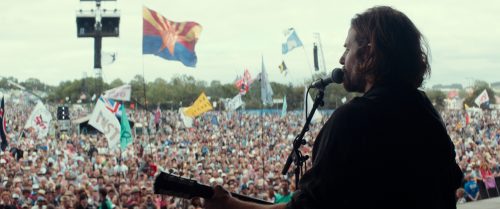
Libatique: The first live performances we shot were at Coachella and that sort of built the foundation for how we would even shoot the narrative bits of the movie in terms of using a broad lighting scenario that could work for improvisation and camera movement that allowed for adjustment. Philosophically for the film, we wanted to keep the light as unobtrusive as possible and give the camera the flexibility to adjust to the performance so that the actors would feel safe enough to improvise and adjust.
I think technically getting Ally’s first introduction to the stage for when she performs “Shallow” (at the Greek Theatre) was the one that caused the most anxiety just because we really wanted to get that right. And that was one of the shows that we controlled. Then for the first performance you see in the film, that was literally just us shooting between the sets of Jamey Johnson and Willie Nelson at Stagecoach. We basically had ten minutes to shoot two takes of Bradley performing. My gaffer had to run over to the dimmer board and start pressing buttons haphazardly because the (venue’s) dimmer board operator walked away thinking it was his break.
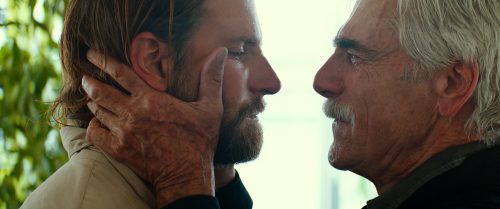
Filmmaker: There’s this great close-up of Bradley Cooper and Sam Elliott, who plays his brother and road manger, where Elliott sort of grabs ahold of Cooper’s face in this profile two-shot. Was that something that was planned or did it come about through that sense of improvisation you were talking about?
Libatique: We had the A Camera on Bradley for his close-up and normally the B Camera would then be on (a reverse of) Sam, but instead we kept the B Camera in profile because something told me that we needed to see these two men in the same frame. When we switched the A Camera over to the other side for Sam’s coverage, we kept the B Camera in the profile but we went tighter and that’s the shot you’re talking about. On set we couldn’t take our eyes off of that specific image. They’re just masterful actors and sometimes when you have two masterful performers you want to see them doing their thing in the frame together.
Filmmaker: Dave Chappelle is certainly a less experienced actor than Sam Elliott, but he’s actually pretty great in a scene he shares with Cooper where he talks about giving up some of his musical dreams to spend more time with his family. He has a monologue that plays mostly in one shot.
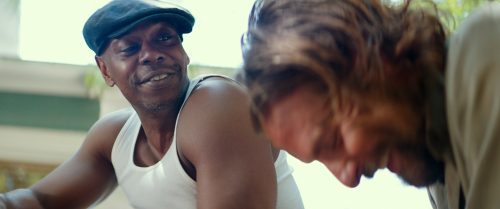
Libatique: There were only three shots in that scene — there was one with the camera behind their backs to sort of set the scene, then there was the over onto Dave, and then there was an over onto Bradley. But yeah, most of the scene is played on Dave because it’s kind of Dave’s scene. You’re learning about him, but you’re also learning about (Cooper’s character) through the eyes of his friend. So editorially they made that choice.
Filmmaker: Chappelle’s one of my favorite stand-ups, but as an actor I really only know him from Half Baked. I didn’t realize he had that kind of performance in him.
Libatique: Part of it is just that Dave is an extremely genuine person and there’s something about two actors working together when one of them is reading really genuine — like Bradley would, time after time — where it becomes infectious. When it’s an intimate movie like this and it’s so emotional and dramatic, these guys feed off of each other.
Filmmaker: You pop up in the movie for a quick cameo as a fashion photographer. How’d they talk you into getting in front of the camera?
Libatique: Yeah, I mean, it wasn’t a stretch, really, was it. (laughs) Bradley was wearing so many hats — he was a producer, he was writing the script with Eric Roth, he was learning how to play guitar, he was working on his voice, and he’s the lead actor and director of the movie. And then you have Lady Gaga, who’s producing all the music and writing all these songs and she’s acting in a movie for the first time. So when Bradley asked me to do it, the least I could do was wear another hat.
Matt Mulcahey works as a DIT in the Midwest. He also writes about film on his blog Deep Fried Movies.
